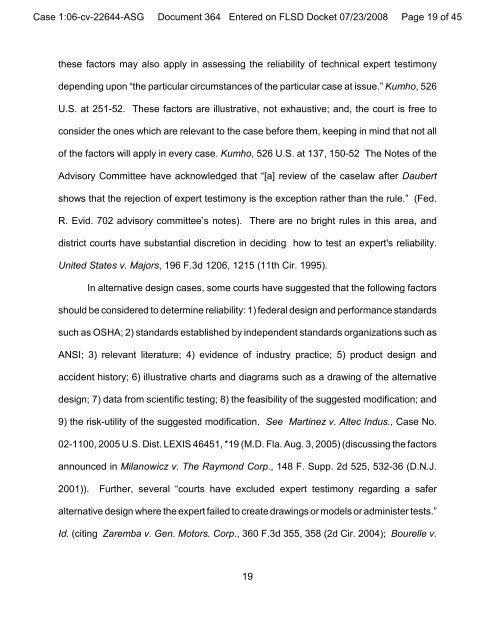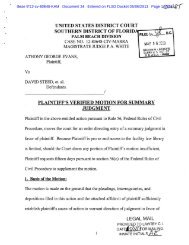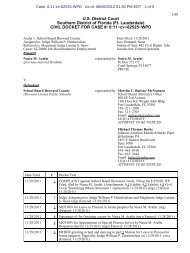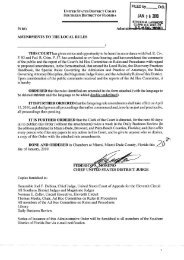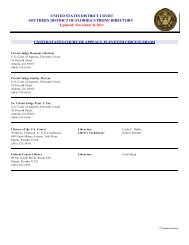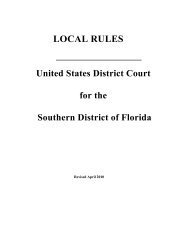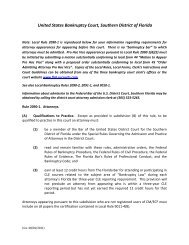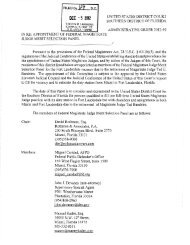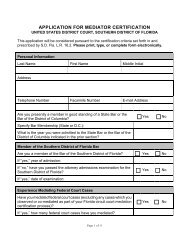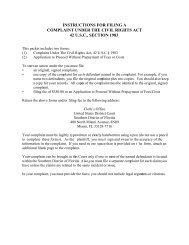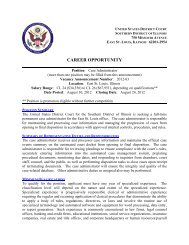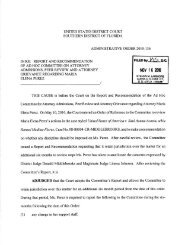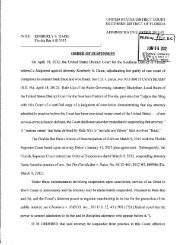Motion in Limine - United States District Court
Motion in Limine - United States District Court
Motion in Limine - United States District Court
Create successful ePaper yourself
Turn your PDF publications into a flip-book with our unique Google optimized e-Paper software.
Case 1:06-cv-22644-ASG Document 364 Entered on FLSD Docket 07/23/2008 Page 19 of 45<br />
these factors may also apply <strong>in</strong> assess<strong>in</strong>g the reliability of technical expert testimony<br />
depend<strong>in</strong>g upon “the particular circumstances of the particular case at issue.” Kumho, 526<br />
U.S. at 251-52. These factors are illustrative, not exhaustive; and, the court is free to<br />
consider the ones which are relevant to the case before them, keep<strong>in</strong>g <strong>in</strong> m<strong>in</strong>d that not all<br />
of the factors will apply <strong>in</strong> every case. Kumho, 526 U.S. at 137, 150-52 The Notes of the<br />
Advisory Committee have acknowledged that “[a] review of the caselaw after Daubert<br />
shows that the rejection of expert testimony is the exception rather than the rule.” (Fed.<br />
R. Evid. 702 advisory committee’s notes). There are no bright rules <strong>in</strong> this area, and<br />
district courts have substantial discretion <strong>in</strong> decid<strong>in</strong>g how to test an expert's reliability.<br />
<strong>United</strong> <strong>States</strong> v. Majors, 196 F.3d 1206, 1215 (11th Cir. 1995).<br />
In alternative design cases, some courts have suggested that the follow<strong>in</strong>g factors<br />
should be considered to determ<strong>in</strong>e reliability: 1) federal design and performance standards<br />
such as OSHA; 2) standards established by <strong>in</strong>dependent standards organizations such as<br />
ANSI; 3) relevant literature; 4) evidence of <strong>in</strong>dustry practice; 5) product design and<br />
accident history; 6) illustrative charts and diagrams such as a draw<strong>in</strong>g of the alternative<br />
design; 7) data from scientific test<strong>in</strong>g; 8) the feasibility of the suggested modification; and<br />
9) the risk-utility of the suggested modification. See Mart<strong>in</strong>ez v. Altec Indus., Case No.<br />
02-1100, 2005 U.S. Dist. LEXIS 46451, *19 (M.D. Fla. Aug. 3, 2005) (discuss<strong>in</strong>g the factors<br />
announced <strong>in</strong> Milanowicz v. The Raymond Corp., 148 F. Supp. 2d 525, 532-36 (D.N.J.<br />
2001)). Further, several “courts have excluded expert testimony regard<strong>in</strong>g a safer<br />
alternative design where the expert failed to create draw<strong>in</strong>gs or models or adm<strong>in</strong>ister tests.”<br />
Id. (cit<strong>in</strong>g Zaremba v. Gen. Motors. Corp., 360 F.3d 355, 358 (2d Cir. 2004); Bourelle v.<br />
19


